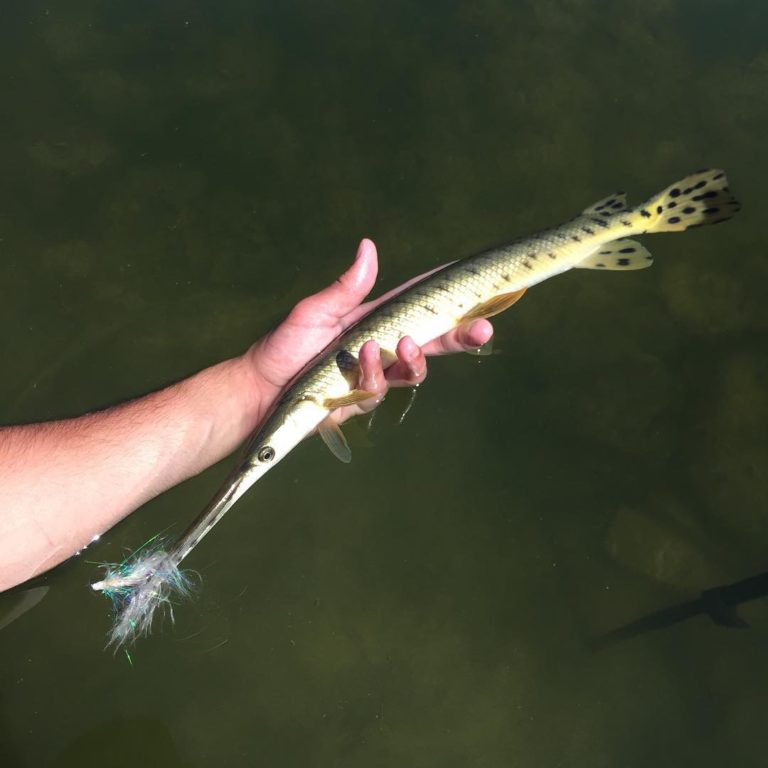The Longnose Gar

The longnose gar (Lepisosteus osseus) is a very unique fish found in many areas of western New York. Longnose gar typically range between 24 and 36 inches in length and can be identified by their narrow body and long snout, which is filled with numerous needle like teeth. Longnose gar have a light tan body with back spots and thick, rough scales. It is very difficult to misidentify a longnose gar.
Longnose gar are fascinating fish in and of themselves. The longnose gar is truly a living fossil, as their aesthetic dates back 100 million years. Longnose gar are one of the three “living fossils” found here in western New York, the other two being the bowfin and the sturgeon. The fact that longnose gar have changed very little over the past 100 million years attests to their ability to survive in many challenging environments.
Habitat
Longnose gar are most frequently found in the lower reaches of large creeks and rivers in western New York, especially during the warm part of the year. Longnose prefer laying motionless in the sluggish stretches of creeks waiting for unsuspecting prey to venture too close to their long, toothy snouts. Longnose gar will often hang around in shallow bays near the mouth of creeks as well. Longnose gar will sometimes congregate around fallen trees, large rocks, or other structure.
Longnose gar are adept to survive in even the harshest of environments and can easily survive in excessively warm water that is devoid of oxygen. Longnose gar are able to survive in oxygen deprived environments by using their modified swim bladder to breathe air. One can often observe longnose gar surfacing in creeks in a manner similar to that of trout feeding off the surface. However, it is unlikely that surfacing longnose gar are feeding. It is more likely that they are actually gulping air and using their modified swim bladder to breathe.
Food
A longnose gar’s diet probably consists entirely of small baitfish. To hunt, longnose gar usually lie motionless in the water waiting for prey. Longnose gar are well camouflaged and blend in perfectly with the creek bed. A longnose gar laying suspended in the water is difficult to see and is often mistaken for a stick. Once prey ventures within striking distance, the gar will quickly turn its head and snap down on its prey, impaling it with hundreds of needle-like teeth. Longnose gar can occasionally chase fish but usually only those that are slow or injured.
Where to Catch Longnose Gar
Longnose gar can probably be found in every county of western New York, but are particularly common in Lake Erie and Ontario tributaries. The best tributaries to find longnose gar are large, sluggish tributaries. For Lake Erie, the lower stretches of 18 Mile Creek and Cattaraugus Creek are good spots to target longnose gar. For Lake Ontario, 18 Mile Creek and the Oak Orchard River are likely good spots. Don’t be afraid to check the lower stretches of other Erie or Ontario tributaries as well because they probably contain longnose gar too.
The best time of year to target longnose gar is late May through early July. During this time, large numbers of longnose gar can be found in the lower stretches of Erie and Ontario tributaries and bays and inlets close to tributary mouths. During the remainder of the summer, some longnose gar may still reside near tributary mouths, especially in large Ontario tributaries. It is best to sight-fish for gar; if you find one, there are likely many more in close proximity.
How to Catch Longnose Gar
Longnose gar can be caught on both live bait and artificial lures. The best live bait to use for longnose gar is probably minnows as minnows constitute the majority of a gar’s diet. However, the biggest problem that arises when live bait fishing for longnose gar is the inability to get a hook set because the mouths of longnose gar are bony and hard.
To circumvent the problem of getting a hook set, another less harmful approach can be used. Instead of hooking the gar, you can make your own lures out of frayed nylon rope that catch gar by entangling teeth. A rope lure can be made by first cutting a piece of ¼ inch thick nylon rope 4-5 inches long. After you cut the rope, fray it as much as possibly with a comb or brush. Then, tie in the tip of the frayed rope towards the eye of a long hook. You can then tie in flashy material to give your lure some life.
Rope lures can be fished on the fly or with a spinning rod. When using a rope lure, cast it out and allow it to remain still for several seconds. Then, slowly jerk the fly back to you mimicking the erratic behavior of an injured minnow. Gar will frequently follow your fly literally up to your feet, then turn away. Gar fishing requires quite a bit of persistence, but with enough casts you should be able to fool one into biting. If you catch one, grab it gently behind the head and work the frayed nylon out of its teeth with forceps. Do not grab gar by the mouth or you will be sorry!
